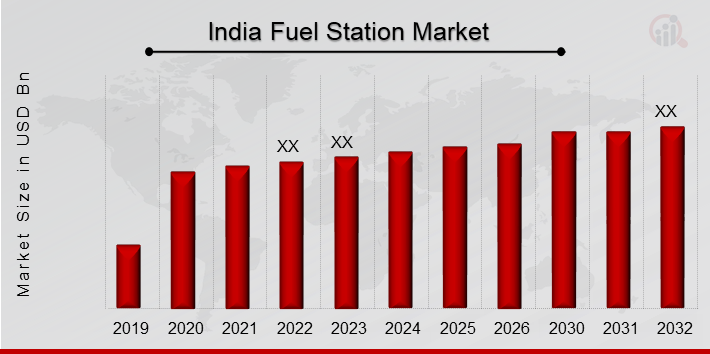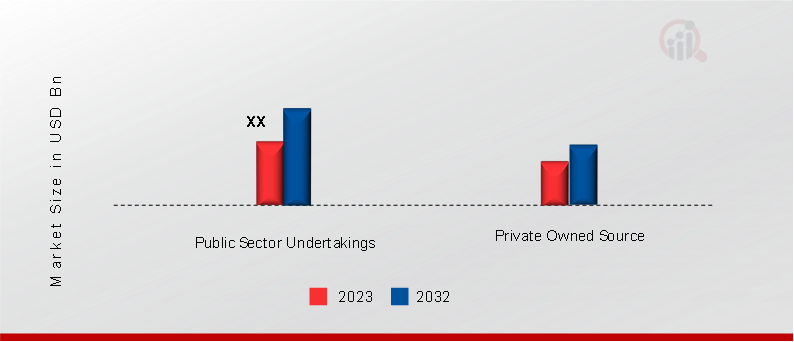India Fuel Station Market Overview:
India Fuel Station Market Size was valued at USD 11.2 Billion in 2023. The India Fuel Station market industry is projected to grow from USD 13.1 Billion in 2024 to USD 21.2 Billion by 2032, exhibiting a compound annual growth rate (CAGR) of 5.3% during the forecast period (2024 - 2032). The growing demand for energy and increasing adoption of alternative fuels, coupled with the expansion of electric vehicle infrastructure, are the main market drivers anticipated to propel the Fuel Station market in India.

Source: Secondary Research, Primary Research, MRFR Database and Analyst Review
India Fuel Station Market Trends
The rise of alternative fuels is driving the market growth
The increasing prominence of alternative fuels is shaping the fuel station market. As concerns over environmental sustainability and climate change continue to escalate, there has been a notable shift towards cleaner and greener energy sources in the transportation sector. This shift is evident in the growing adoption of alternative fuels such as compressed natural gas (CNG), liquefied natural gas (LNG), hydrogen, and biofuels. These alternatives offer lower carbon footprints compared to traditional fossil fuels, aligning with global efforts to reduce greenhouse gas emissions. The rise of alternative fuels is driven by a combination of regulatory initiatives, consumer preferences, and technological advancements. Governments around the world are implementing stringent emission norms and offering incentives to promote the use of alternative fuels. Consumers, increasingly environmentally conscious, are choosing vehicles that run on cleaner energy sources, thereby driving the demand for fuel stations offering these alternatives. Additionally, advancements in technology have made the production and distribution of alternative fuels more viable, contributing to their increased availability at fuel stations.
Another transformative trend in the fuel station market is the rapid electrification of transportation and the consequent expansion of electric vehicle (EV) charging infrastructure. As the automotive industry undergoes a significant shift towards electric mobility, fuel stations are evolving to cater to the changing needs of electric vehicles. The rise in electric vehicle adoption is driven by factors such as government incentives, advancements in battery technology, and increasing awareness of the environmental benefits associated with electric vehicles. Fuel stations are increasingly incorporating electric vehicle charging points alongside traditional fuel dispensers. This shift not only addresses the changing consumer preferences but also aligns with the broader global push toward sustainable transportation. The expansion of EV charging infrastructure involves the installation of fast-charging stations, offering convenience and shorter charging times for electric vehicle users. Moreover, strategic partnerships between fuel station operators and electric vehicle manufacturers contribute to the seamless integration of charging facilities. This trend is reshaping the competitive landscape of the fuel station market as operators compete to establish themselves as leaders in electric vehicle charging. The adaptability of fuel stations to cater to both traditional and electric vehicles reflects a forward-looking approach that acknowledges the coexistence of multiple energy solutions in the future of transportation. As electric vehicle adoption continues to rise, fuel stations that successfully embrace and invest in electrification are likely to secure a competitive edge in this evolving market.
India Fuel Station Market Segment Insights:
Fuel Station Ownership Insights
The India Fuel Station market segmentation, based on Ownership, includes public sector undertakings and private owned source. The public sector undertakings category tends to dominate the ownership segment in the fuel station market. Governments are usually involved in the regulation and distribution of fossil fuels, ensuring energy security and stability in the country. Public sector undertakings are established with the primary objective of serving the public interest, and their involvement in the fuel station sector aligns with national energy policies. Governments may also use these entities to control fuel prices and maintain stability in the energy sector, which is crucial for overall economic health.
Figure 1: India Fuel Station Market, by Ownership, 2024 & 2032 (USD Billion)

Source: Secondary Research, Primary Research, MRFR Database and Analyst Review
Fuel Station End User Insights
The India Fuel Station market segmentation, based on end user, includes the public sector and private sector. The private sector category tends to dominate the fuel station market. Private sector entities are often more agile and responsive to market dynamics. They can quickly adapt to changing consumer preferences and technological advancements in the fuel and energy sector. This agility allows them to efficiently implement innovations such as advanced payment systems, loyalty programs, and environmental sustainability measures, enhancing the overall customer experience.
Fuel Station Country Insights
The Fuel Station Market in India is experiencing robust growth due to several key factors. The country's sustained economic development and urbanization have led to an increase in the number of vehicles on the road, driving up the demand for fuel stations. As more individuals and businesses acquire vehicles, the need for convenient and accessible fueling infrastructure grows. The government's focus on expanding and modernizing the country's transportation infrastructure has spurred the growth of the fuel station market. Initiatives such as the Bharat Stage VI emission standards and the promotion of alternative fuels have driven investments in upgrading existing fuel stations and establishing new ones to align with evolving regulatory requirements.
Additionally, the rising awareness of environmental sustainability and the push towards cleaner energy sources has led to the integration of electric vehicle charging infrastructure within fuel stations. This diversification of services caters to the changing landscape of transportation preferences, contributing to the overall growth of the fuel station market in India. Furthermore, increased foreign direct investment (FDI) in the energy sector and collaborations between domestic and international players have infused capital into the market, supporting the expansion and modernization of fuel station networks across the country. As India continues to experience economic growth and technological advancements, the fuel station market is poised for further expansion to meet the evolving needs of the rapidly developing nation.
Fuel Station Key Market Players & Competitive Insights
Leading market players such as fuel station operators often expand their offerings beyond traditional fuel sales. Diversification may include the integration of convenience stores, car wash services, and partnerships with food and retail outlets. Market participants are also undertaking a variety of strategic activities to expand their footprint, with important market developments including new Ownership launches, contractual agreements, digitalization and technology integration, mergers and acquisitions, cost competitiveness, higher investments, and collaboration with other organizations. To expand and survive in a more competitive and rising market climate, the Fuel Station industry must offer cost-effective items.
Major players in the Fuel Station market are attempting to increase market demand by investing in research and development operations, including Indian Oil Corporation Ltd, Bharat Petroleum Corp. Ltd, Reliance Industries Limited, Royal Dutch Shell PLC, TotalEnergies SA, Hindustan Petroleum Corporation Limited, and Nayara Energy Limited.
Key Companies in the India Fuel Station market include
India Fuel Station Industry Developments
In February 2023, Indian Oil Corporation Limited (IOCL), a state-owned refiners and oil marketer company, made an announcement that in the financial year 2023, the company intends to invest USD 25.44 in the state of West Bengal. The company's objective hinged upon the Investor to expand the investment to establish and enhance the infrastructure towards greener retail fuels. By the end of 2022, the green auto fuel will be available in 275 retail outlets across the country, but this figure is expected to increase to more than 1,000 by the end of 2024. Further, PSUs enjoy the availability of more fuel pricing control due to the presence of government policies steering them. This enables them to offer competitive prices and stabilize the ex-fuel prices and thus offer stability to the consumers.
As per a report published in 2024, Nayara Energy, a private oil refinery is seeking to grow its retail gasoline and diesel network expanding business avenues in India targeting to increase its present retail fuel stations from the current 6,400 by 50% approximately by 2030. The company made a net profit of Rs 9,592 crore on an operational revenue of Rs 1.37 trillion in FY23 posted earlier, and also aims to be a bigger player in the downstream petroleum value chain by branching out in the petrochemical sector, audience was told by Chief Financial Officer, Rajani Kesari to Arunima Bharadwaj. Nayara will focus on the refining margins with the country's second-largest single-location oil refinery, irrespective of any volatility in global crude oil prices, she says.
India Fuel Station Market Segmentation:
Fuel Station Ownership Outlook
- Public Sector Undertakings
- Private Owned Source
Fuel Station End User Outlook
- Public Sector
- Private Sector
| Report Attribute/Metric |
Details |
| Market Size 2023 |
USD 11.2 Billion |
| Market Size 2024 |
USD 13.1 Billion |
| Market Size 2032 |
USD 21.2 Billion |
| Compound Annual Growth Rate (CAGR) |
5.3% (2024-2032) |
| Base Year |
2023 |
| Market Forecast Period |
2024-2032 |
| Historical Data |
2019- 2022 |
| Market Forecast Units |
Value (USD Billion) |
| Report Coverage |
Revenue Forecast, Market Competitive Landscape, Growth Factors, and Trends |
| Segments Covered |
Ownership, End User, and Region |
| Countries Covered |
India |
| Key Companies Profiled |
Indian Oil Corporation Ltd, Bharat Petroleum Corp. Ltd, Reliance Industries Limited, Royal Dutch Shell PLC, TotalEnergies SA, Hindustan Petroleum Corporation Limited, and Nayara Energy Limited. |
| Key Market Opportunities |
The increasing focus on environmental sustainability presents an opportunity for fuel station operators to integrate alternative fuels into their offerings. There is an opportunity for fuel stations to expand their services beyond traditional fueling. |
| Key Market Dynamics |
The rising Ownership of vehicles, both traditional internal combustion engine vehicles and electric vehicles, is a significant driver for the fuel station market. Government policies and regulations play a crucial role in driving the fuel station market. |
Frequently Asked Questions (FAQ) :
The India Fuel Station market size was valued at USD 11.2 Billion in 2023.
The market is projected to grow at a CAGR of 5.3% during the forecast period, 2024-2032.
The key players in the market are Indian Oil Corporation Ltd, Bharat Petroleum Corp. Ltd, Reliance Industries Limited, Royal Dutch Shell PLC, TotalEnergies SA, Hindustan Petroleum Corporation Limited, and Nayara Energy Limited, among others.
The Public Sector Undertakings (PSUs) category dominated the market in 2024.
The Private Sector category dominated the market in 2024.















